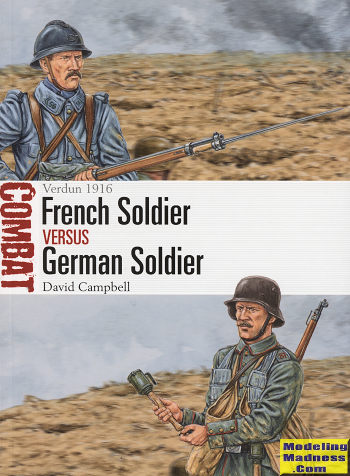 Osprey
seems to have hit on a type of book that has become fairly popular. These books
pit either soldiers or equipment against each other and allow us to see how they
perform against each other. For the equipment it is the Duel series and for
people it is this Combat series. #47 in the series pits the French Army against
the German Army at Verdun.
Osprey
seems to have hit on a type of book that has become fairly popular. These books
pit either soldiers or equipment against each other and allow us to see how they
perform against each other. For the equipment it is the Duel series and for
people it is this Combat series. #47 in the series pits the French Army against
the German Army at Verdun.
By late 1915, trench warfare had become the norm. This sort
of warfare produced minimal gains (if any) and required maximum effort for the
attacker. Things were not roses for the defenders as these attacks were
generally preceded by fairly intensive artillery. This resulted in not only
destruction of defenses, but also the death and injury of a goodly number of
defenders.
Then the attackers had to face a moonscape through which any
sort of quick advancement was nigh impossible. It also put them fairly much out
in the open for any counter artillery and the machine guns of the defenders. It
was not uncommon for a unit to have 50% casualties during the attack phase.
In the time period of this book, the concentration was the
fortress city of Verdun. This had the advantage for the Germans of being quite
close to a railhead so that getting supplies was not a major issue and the
attacking force could really build up prior to the actual attack. On the French
side, the guns and most of the troops occupying the surrounding forts had been
pulled away for use at other sectors. Once the German build up had been noticed,
it was too late to do much about the gun situation and while some troops were
brought in for reinforcements, building up the defenses was unable to reach
completion. The result is that the Germans made some inroads, but not as
expected in what turned into a very prolonged campaign.
As is the standard for this series, we are provided a fairly
good look at the historical background, as well as the leaders and troops of
both sides. This includes the training and the equipage of these troops. A look
at the tactical and strategic situation of the sector is also provided. Then we
are provided with three different battles during the campaign. In this case Bois
du Caures, the initial assault of late February 1916. We then move to Mort Homme
in April of 1916. Finally on to Fort Vaux in June of 1916. Each of these battles
shows how well tactics worked and what was learned from the previous
experiences. Then we are provided with an overall analysis.
In all, it makes for a super read of what in my mind was some
of the most horrific fighting of that conflict. A book from which I learned and
lot and one that I am sure you will like as well.
March 2020
For more on the complete line of Osprey books and to order
this one, visit
www.ospreypublishing.com
.
If you would like your product reviewed fairly and quickly, please contact
the editor or see other details in the Note to
Contributors.
 Osprey
seems to have hit on a type of book that has become fairly popular. These books
pit either soldiers or equipment against each other and allow us to see how they
perform against each other. For the equipment it is the Duel series and for
people it is this Combat series. #47 in the series pits the French Army against
the German Army at Verdun.
Osprey
seems to have hit on a type of book that has become fairly popular. These books
pit either soldiers or equipment against each other and allow us to see how they
perform against each other. For the equipment it is the Duel series and for
people it is this Combat series. #47 in the series pits the French Army against
the German Army at Verdun.